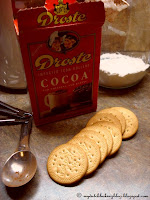Breakfast is always a treat in Holland. The amount of cold cuts is amazing, the cheese is fabulous and the large variety of breads always makes it difficult to choose from. If you're not in the mood for bread, you can pick a Dutch rusk, beschuit, a cracker or a large slice of Dutch "breakfast cake" or ontbijtkoek.
Ontbijtkoek is a cake-like quick bread, soft, sweet and with a variety of spices and flavors. The enticing mix of cinnamon, ground cloves and nutmeg is the basis for a large variety of different breads: ontbijtkoek is also known as peperkoek if it also contains a snuff of white pepper, honingkoek if it has an additional amount of honey, gemberkoek if the cake is studded with candied ginger or kandijkoek when the top of the cake is covered in sugary pearls.
Not all ontbijtkoeken are solely consumed for breakfast. The koek can be sliced and eaten by itself, dry, or improved with a dab of real butter as a snack, or with a cup of coffee. Children will often get a slice to hold them over until dinner, and a popular game at birthdays and national celebrations is "koekhappen", cake nipping. Thick slices of ontbijtkoek are individually suspended on a larger rope, so that they dangle right above the heads of the, sometimes blindfolded, children. Adults on either side of the rope will lower the koek until right above the children's heads who, in order to get a bite out of the cake, have to jump up and nip at the delicacy. First one to finish the koek is declared the winner! The Dutch company Peijnenburg, famous for its koeken, uses koekhappen in most of their commercials: this one is still my favorite!
This morning I was in the mood for honingkoek. It's an easy cake to bake, it fills the house with lovely smells and it's a perfect afternoon snack for later. If you have all the ingredients, this cake can be on your breakfast table in the time it takes you to get the newspaper, make a pot of coffee and toast the bread.
This recipe is for an 8 x 4 inch loaf pan: double the recipe and you'll be able to bake two (save one in the freezer for later!), or bake a larger koek in a 9 x 5 loaf pan. If you do, stick to one egg, and increase your baking time to 50 minutes.
 Honingkoek
Honingkoek
2 cups self-rising flour (300gr) or two cups regular flour and 2 tsp baking powder)
1/2 cup (75 grams) brown sugar
1 tsp cinnamon
1/4 tsp ground aniseed (optional)
1/4 tsp ground cloves
1/4 tsp ground nutmeg
Pinch of salt
1/2 cup of honey (75 gr)
1 cup of milk (120 ml)
1 egg
Grease an 8 x 4 cake pan. Preheat oven to 350F. Add all the dry ingredients to a bowl and mix together. Set the mixer on low and add the wet ingredients, one at a time. Scrape the sides of the bowl once or twice. Mix until you have a smooth batter, approx. 2 minutes. Pour the batter into the pan, bake for 30 minutes or until a toothpick comes out clean. Let the ontbijtkoek cool on a wire rack, then slice and serve with butter. Best saved in a plastic bag at room temperature, will keep for several days.
Not all ontbijtkoeken are solely consumed for breakfast. The koek can be sliced and eaten by itself, dry, or improved with a dab of real butter as a snack, or with a cup of coffee. Children will often get a slice to hold them over until dinner, and a popular game at birthdays and national celebrations is "koekhappen", cake nipping. Thick slices of ontbijtkoek are individually suspended on a larger rope, so that they dangle right above the heads of the, sometimes blindfolded, children. Adults on either side of the rope will lower the koek until right above the children's heads who, in order to get a bite out of the cake, have to jump up and nip at the delicacy. First one to finish the koek is declared the winner! The Dutch company Peijnenburg, famous for its koeken, uses koekhappen in most of their commercials: this one is still my favorite!
This morning I was in the mood for honingkoek. It's an easy cake to bake, it fills the house with lovely smells and it's a perfect afternoon snack for later. If you have all the ingredients, this cake can be on your breakfast table in the time it takes you to get the newspaper, make a pot of coffee and toast the bread.
This recipe is for an 8 x 4 inch loaf pan: double the recipe and you'll be able to bake two (save one in the freezer for later!), or bake a larger koek in a 9 x 5 loaf pan. If you do, stick to one egg, and increase your baking time to 50 minutes.
 Honingkoek
Honingkoek2 cups self-rising flour (300gr) or two cups regular flour and 2 tsp baking powder)
1/2 cup (75 grams) brown sugar
1 tsp cinnamon
1/4 tsp ground aniseed (optional)
1/4 tsp ground cloves
1/4 tsp ground nutmeg
Pinch of salt
1/2 cup of honey (75 gr)
1 cup of milk (120 ml)
1 egg
Grease an 8 x 4 cake pan. Preheat oven to 350F. Add all the dry ingredients to a bowl and mix together. Set the mixer on low and add the wet ingredients, one at a time. Scrape the sides of the bowl once or twice. Mix until you have a smooth batter, approx. 2 minutes. Pour the batter into the pan, bake for 30 minutes or until a toothpick comes out clean. Let the ontbijtkoek cool on a wire rack, then slice and serve with butter. Best saved in a plastic bag at room temperature, will keep for several days.












